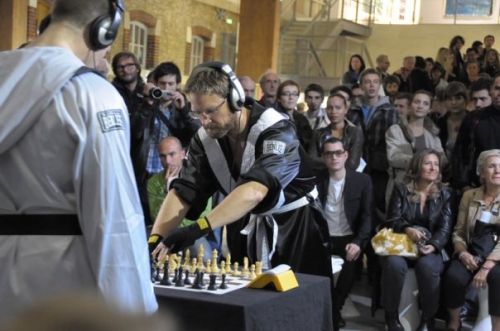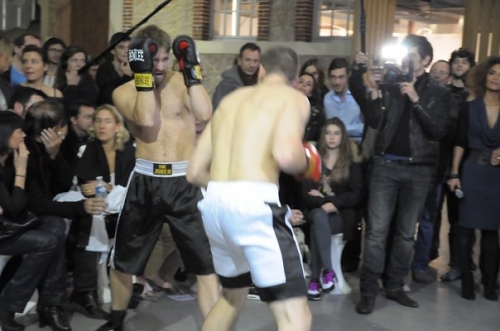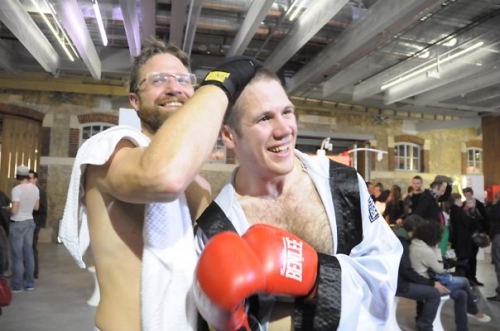Thursday, October 22, 2009. The hand of the watch I'm not wearing has just passed the thirtieth minute after eight o'clock, somewhere in the sumptuous basement of 104, a few hundred meters from Gonzai's slightly less flashy offices. . We are in the heart of the 19th arrondissement. We are above all in the heart of the Parisian art week.
In the middle of a package of more or less overpriced canvases and installations, between two dithyrambic awards and without second degree of which art lovers have the secret, an attentive and slightly disoriented crowd awaits the event which will give the starting signal of the Slick, one of FIAC's contemporary art fairs. The two fighters, serene and smiling, far from the exaggerated facial expressions of classic boxers, enter in turn the center of a mock ring delimited by stools. The announcer rants about some factual information to familiarize the public with the sport he is about to discover. The two boxers, in shorts and bathrobes, stare at each other with smiles, and settle down in the center of the ring, facing each other in front of a chessboard. This is not a boxing match.
Initially, Chess-Boxing was just one madness among others, straight out of the tortured mind of designer Enki Bilal. The principle is intended to be as simple as the genius of the idea. Two fighters compete for victory, alternating a round of chess and a round of boxing. Winning fate of the confrontation, the first to inflict "Checkmate" or "Knock Out" to the other before the limit of eleven rounds. By combining physical and intellectual challenge, all the subtlety of this singular art is as much due to the ability of the fighter to manage this oxygen which irremediably leaks from the brain to be distributed in the muscle, as to the ability to remain lucid and be able to resume a game of chess that we left three minutes earlier - the punches in the face don't not particularly helpful in this regard. The fight takes place in the ring, the wars are fought on the chessboard*.
Concretely, the concept could have remained buried in the comic strip "Froid Equateur" released in 1992, if Iepe Rubingh, Dutch artist exiled in Berlin, had not had the ambition one day in 2003 to transpose this two-headed sport to reality. . In barely six years, he will have succeeded in the tour de force of constituting a real world federation which to date has around three hundred fighters distributed within an axis going mainly from Moscow to Berlin, passing quickly through Paris and Los Angeles. Still a very young discipline, chess-boxing seems to be following a solid dynamic, according to the multiplication of clubs and Facebook groups - a marker of the time if there ever was one. Like any sports organizer with ambitions for global development, Iepe Rubingh has already mounted several world championships, dreams of conquering America by organizing a pharaonic match in Los Angeles and plans in the somewhat distant future to submit his hybrid sport to this monster of corruption that is the IOC. In the hope of making it an Olympic discipline in its own right.
In this timorous 104 true to his image, Iepe “The Joker†Rubingh, himself, faces Carl “Le Manouche†Strugnell, one of the very first French chess-boxers, who is playing his third match tonight.
The first totals almost ten years of boxing in the fists and in the legs, when the second has ten times less practice but can boast of a background of twenty-two years of cohabitation with the pawns. During the rounds of chess which last four minutes, the fighters don helmets to cut themselves off from the incessant flow of words from the announcers who comment on the evolution of the fight which takes place on the roulette table. Then alternate with three minutes of boxing. Chess. Boxing. Chess. Boxing. Chess. Boxing.
And so begins the seventh round. The Manouche is beginning to clearly show fatigue under the battering of the Joker. Never mind, his long practice of chess allows him, in his own words, to benefit from reflexes that go beyond even the concept of automatism. The lack of oxygen from which his brain suffers is not even problematic as the black and white matrix is ​​imprinted in the depths of his soul. This decisive advantage allows him to lay down his opponent in extremis, avoiding him at the same time to put on the gloves again, in a round which could well have led him to taste the coldness of the gray ground of the 104. The two boxers, upright in their boots, congratulate each other sincerely. The part of the audience that stayed until the end seems to have enjoyed the performance. Enki Bilal, present for the occasion, cordially congratulates the winner, although overall he seemed to be pissed off. End of the exhibition, everyone can now resume the course of their existence and begin to clumsily comment on the weight of the world condensed into a few artistic products. Sipping champagne.
* "Fighting is done in the ring - Wars are waged on the board" is the official motto of the World Chess-Boxing Organization |
|













